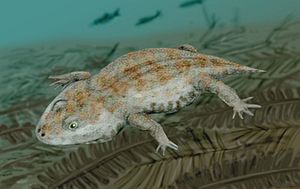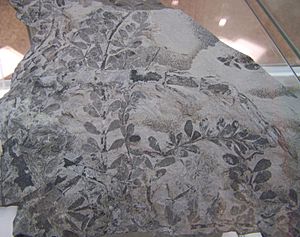Paleontology in Illinois facts for kids
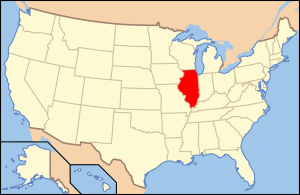
Paleontology in Illinois is all about studying ancient life in the state of Illinois. Scientists have found that Illinois was once covered by a warm, shallow sea during the Paleozoic Era. This sea was home to many different creatures. These included shelled animals like brachiopods and clams. There were also corals, crinoids (sea lilies), sea snails, sponges, and trilobites.
You can find many fossils in Illinois from the Ordovician to the Pennsylvanian periods. Illinois is famous for its many well-preserved trilobite fossils. There is a long gap in Illinois' fossil record from the Mesozoic to the Pleistocene eras. During the Ice Age, huge glaciers covered parts of Illinois. At that time, animals like giant beavers, mammoths, mastodons, and stag mooses lived here.
The study of fossils in Illinois began a long time ago, in the 1850s. This is when the first Mazon Creek fossils were found. Later, in the 1950s, a man named Francis Tully discovered a strange creature. It was later named the "Tully Monster" in his honor. This creature, Tullimonstrum gregarium, is the official state fossil of Illinois. It's special because it's only found in Illinois!
Contents
Ancient Illinois: A Look Back in Time
No fossils from the Precambrian era have been found in Illinois. So, the state's fossil story begins in the Paleozoic Era. During this time, Illinois was covered by a warm, shallow sea. This sea was home to many different animals. These included brachiopods, clams, corals, crinoids, snails, sponges, and trilobites.
About 500 million years ago, during the Cambrian Period, the seas in Illinois looked like the modern Bahamas. Illinois was located near the equator back then. Trilobites lived in Illinois during this time. Their fossils are found in the north-central part of the state. In other areas, Cambrian trilobite fossils are only found deep underground.
Ordovician Period: Sea Creatures Thrive
During the Ordovician Period, Illinois was still near the equator. It was still covered by a shallow, warm sea. Graptolites, which were tiny colonial animals, were very common then. Their fossils are found in northern Illinois. Cephalopods, like ancient squid, were also diverse. Some had straight shells, while others had coiled shells. Their fossils are found in northern and western Illinois.
Gastropods (snails) were common. "Sunflower coral" sponges were also common in north-central Illinois. Trilobites were still around. Ordovician rocks have more trilobite fossils than Cambrian rocks. This is because Ordovician rocks are easier for people to find. Ordovician trilobites in Illinois included Isotelus and Ceraurus. Their fossils are found in northern and southwestern Illinois.
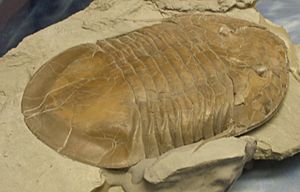
Marine worms lived in the muddy seafloor. We know this from fossils of their tiny jaws. After the Ordovician, the number and types of trilobites decreased a lot.
Silurian Period: Reefs and Worm Jaws
Warm, tropical sea conditions continued into the Silurian Period. Trilobites were still present. Like the Ordovician, Silurian rocks are a better place to find trilobite fossils than Cambrian rocks. This is because Silurian rocks are easier to reach. Silurian trilobites from Illinois included Dalmanites and Calymene. Their fossils are found in northern and southwestern Illinois.
Hindia sponges lived near Chicago during the Silurian. Another Silurian creature in the Chicago area was cystoids. Most cystoid fossils from Illinois are found in deposits from that time and place. Fossils of marine worm jaws are even more common in northeastern Illinois from the Silurian. After the Silurian Period, the number and types of Illinoisan trilobites continued to decline.
Devonian Period: More Trilobites
During the Devonian Period, Illinois was still covered by the sea. It had not moved far north from the equator. Trilobites were still present. Devonian trilobites found in Illinois included Phacops and Odontocephalus.
Mississippian Period: Sea Life Abounds
Illinois was still under seawater during the early Carboniferous Period. Tiny colonial animals called bryozoans were very common across Illinois during the Mississippian Period. Brachiopods were also very common in the Mississippian rocks near the Mississippi River and Ohio River areas. A Mississippian trilobite from Illinois was Brachmetopus.
Pennsylvanian Period: Swamps and Strange Creatures
Illinois was still near the equator during the Pennsylvanian Period. Western and central Illinois had many swamps. These swamps were next to the last parts of the shallow sea that once covered the state. Tiny shelled creatures called fusulinids are common in Pennsylvanian rocks. Shelled cephalopods were diverse, some with straight shells, others coiled.
Other creatures included the famous Tully monster. There were also animals that look like modern life, such as shrimp, jelly fish, sharks, and squid. Coelacanths, a type of fish, were among the aquatic animals. Gastropods (snails) were common. Clams were common in central Illinois. Horseshoe crab fossils from Illinois are only found in the Mazon Creek area from this period. Trilobites were still present, including Ameura and Ditomopyge.
About 325 million years ago, Illinois was covered in thick, forested deltaic swamps. The trees in these Pennsylvanian forests included Cordaites, scale trees, and seal trees. Some of these trees grew over 100 feet tall! Other plants included scouring rushes, Sphenophyllum, ferns, and seed ferns. Their fossils include casts, molds, and even whole plants preserved in rock nodules. Rivers flowing through these ancient swamps carried leaves and plant bits out to sea. The environment of Pennsylvanian Illinois was similar to the modern Amazon River delta. Almost every Pennsylvanian rock layer in Illinois shows signs of these ancient plants. These ancient swamp plants became Illinois' modern coal deposits.
More than 130 types of insects lived in the Pennsylvanian Mazon Creek area. These insects were typical for a woodland near the sea. Some looked like modern dragonflies, roaches, and damselflies. Others were unlike anything alive today. Other land invertebrates included early scorpions and different types of primitive spiders. Mazon Creek also had small amphibians like Amphibamus grandiceps. This amphibian might be related to the group that led to modern frogs. Some amphibians in these swamps grew up to ten feet long! Some early vertebrates found in Mazon Creek's rock nodules even have fossilized soft tissues.
There are no rocks from the Permian Period in Illinois. This means no fossils from that time can be found here. A big event after the Pennsylvanian was a meteor impact near modern Des Plaines. Also, the trilobites died out at the end of the Permian.
Mesozoic Era: A Missing Chapter
Most of the Mesozoic Era is also missing from Illinois' rock record. This is because during that time, sediments were being worn away, not deposited. However, a few Cretaceous Period deposits are found. During the Cretaceous, tiny shelled creatures called foraminiferans lived in Illinois. Plants from this time also left behind fossilized leaves.
Cenozoic Era: Ice Age Animals
There are also few rocks from the Tertiary Period of the Cenozoic Era. Some wildlife from that time was preserved in southern Illinois. But not much else is known about Tertiary Illinois.
The fossil record becomes rich again during the Pleistocene Epoch. About two million years ago, the area where modern Peoria is located was home to the Mississippi River. At the same time, the area of the modern University of Illinois Urbana-Champaign had the Mahomet River. The Mississippi River flowed through Bureau County and Henry County back then. The Mahomet River joined it near Havana.
Illinois had its main periods of glaciation over the last 1.8 million years. These huge glaciers filled in the Mahomet River valley. The melting glaciers carried a lot of sediment. This sediment filled in the original path of the Mississippi River, which then took its modern course. Other meltwater from glaciers formed large lakes.
The glaciers in Illinois moved forward and backward as the climate got colder and warmer. During warm periods, Illinois was home to animals like jaguars, peccaries, and armadillos. During cold periods, Illinois was home to animals like mammoths, mastodons, stag mooses, and giant beavers. Snowshoe hares also lived in Illinois. The Illinoian (stage) glaciation happened about 300,000 to 130,000 years ago. The last time glaciers covered Illinois was during the Wisconsin glaciation, about 25,000 years ago.
History of Discoveries
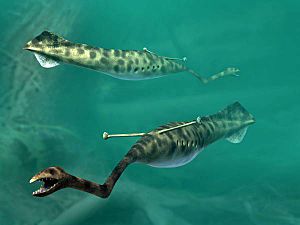
Important fossil discoveries were happening in Illinois as early as the late 1850s. At this time, fossils were found in rock nodules along the Mazon Creek in Grundy County. In the early 1900s, scientists J. H. Bretz and H. A. Lowenstam studied the Silurian fossil reef systems near Chicago.
Later, in the 1920s, coal mining south of Braidwood created piles of waste rock. These piles later became popular places for fossil collectors. Most Tully Monster fossils were found in these waste piles. In the late 1950s, Francis Tully found a fossil he couldn't identify at the strip mines near Braidwood. He took it to Chicago's Field Museum of Natural History. The museum's researchers couldn't identify it either, so it became known as "Mr. Tully's monster."
In 1966, Eugene Richardson, a curator at the Field Museum, officially named the Tully Monster Tullimonstrum gregarium. Finally, in 2016, scientists studied over 1,000 Tully Monster fossils. They decided it belonged to the same group as, and might be related to, lampreys. The Tully Monster is one of the few official state fossils that is only found in its home state.
Famous Paleontologists from Illinois
Many important paleontologists were born in Illinois:
- John Bell Hatcher was born in Cooperstown on October 11, 1861.
- Pierce Brodkorb was born in Chicago on September 29, 1908.
- Charles Repenning was born in Oak Park on August 4, 1922.
- Frederick Schram was born in Chicago on August 11, 1943.
- Sue Hendrickson was born in Chicago on December 2, 1949.
- Paul Sereno was born in Chicago on October 11, 1957.
- Stephen L. Brusatte was born in Ottawa on April 24, 1984.
Some paleontologists also passed away in Illinois:
- Bryan Patterson died in Chicago on December 1, 1979.
Natural History Museums in Illinois
If you want to see fossils and learn more, visit these museums:
- Burpee Museum of Natural History, Rockford
- Elgin Public Museum, Elgin
- Field Museum of Natural History, Chicago
- Jurica-Suchy Nature Museum, Benedictine University, Lisle
- Illinois State Museum, Springfield
- Midwest Museum of Natural History, Sycamore (now closed)
- Peggy Notebaert Nature Museum, Chicago
Clubs and Associations
You can also join groups that love earth science and fossils:
- Earth Science Club of Northern Illinois
- International Fossil Exposition


